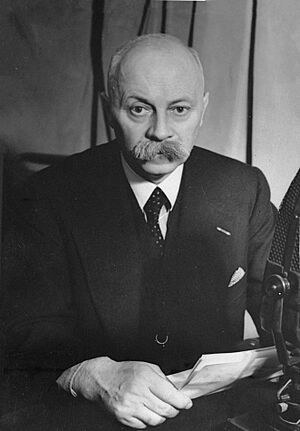Pieter Sjoerds Gerbrandy facts for kids
Quick facts for kids
Pieter Sjoerds Gerbrandy
|
|
|---|---|

Gerbrandy in 1941
|
|
| Prime Minister of the Netherlands | |
| In office 3 September 1940 – 25 June 1945 |
|
| Monarch | Wilhelmina |
| Deputy | Hendrik van Boeijen (de facto) |
| Preceded by | Dirk Jan de Geer |
| Succeeded by | Willem Schermerhorn |
| Member of the House of Representatives | |
| In office 23 October 1956 – 20 March 1959 |
|
| In office 27 July 1948 – 3 July 1956 |
|
| Minister of Colonial Affairs | |
| In office 17 November 1941 – 21 May 1942 |
|
| Prime Minister | Himself |
| Preceded by | Charles Welter |
| Succeeded by | Hubertus van Mook |
| Minister of Justice | |
| In office 23 February 1945 – 25 June 1945 |
|
| Prime Minister | Himself |
| Preceded by | Gerrit Jan van Heuven Goedhart |
| Succeeded by | Hans Kolfschoten |
| In office 10 August 1939 – 21 February 1942 |
|
| Prime Minister | Dirk Jan de Geer (1939–1940) Himself (1940–1942) |
| Preceded by | Johan de Visser |
| Succeeded by | Jan van Angeren |
| Personal details | |
| Born |
Pieter Gerbrandij
13 April 1885 Goënga, Netherlands |
| Died | 7 September 1961 (aged 76) The Hague, Netherlands |
| Political party | Anti-Revolutionary Party |
| Spouse |
Hendrina Elisabeth Sikkel
(m. 1911) |
| Children | 2 sons and 1 daughter |
| Alma mater | Free University Amsterdam |
Pieter Sjoerds Gerbrandy (born Pieter Gerbrandij; 13 April 1885 – 7 September 1961) was an important Dutch politician and a lawyer. He was the Prime Minister of the Netherlands from 1940 to 1945. During World War II, when the Netherlands was occupied by Germany, he led the Dutch government from London, working closely with Queen Wilhelmina. He was a member of the Anti-Revolutionary Party.
Contents
Early Life and Education
Pieter Sjoerds Gerbrandy was born on 13 April 1885. His birthplace was the village of Goënga, which is near Sneek in the province of Friesland, Netherlands. He was from the Frisian ethnic group. His name follows a traditional Frisian style. "Sjoerds" means "son of Sjoerd."
In June 1904, Pieter started studying law at Vrije Universiteit Amsterdam. He earned his law degree in January 1911. After finishing his studies, he worked as a lawyer and a prosecutor from 1911 to 1920.
Beginning His Political Career
Gerbrandy started his political journey in local government. From April 1916 to January 1930, he was a member of the Municipal Council of Sneek. He also served on the Provincial Council of Friesland from July 1919 to August 1920. Later, he was part of the Provincial Executive of Friesland from August 1920 to January 1930.
He continued to be a member of the Provincial Council of Friesland for the Anti-Revolutionary Party (ARP) from 1920 to 1930. In 1939, he became the Minister of Justice, even though his party initially disagreed with this choice.
Leading During World War II
In 1940, Germany invaded the Netherlands during World War II. Because of this, the Dutch royal family and many government leaders had to leave the country. They went to London and formed a government-in-exile.
When the previous prime minister, Dirk Jan de Geer, resigned, Queen Wilhelmina chose Gerbrandy to be the new prime minister. He led the Dutch government from London. During this time, he also served as the Minister of Justice and the Minister of Colonial Affairs. His leadership was very important for the Netherlands during the German occupation.
After the War
After the southern part of the Netherlands was freed in 1945, Gerbrandy created a new government. However, he resigned once the entire country was liberated. He had different ideas about how the Netherlands should deal with Indonesia, which was a Dutch colony at the time.
From 1946 to 1950, he led a group called the National Committee for the Maintenance of the Kingdom's Unity. This group was against Indonesia becoming independent. They also supported the Republic of South Maluku.
In 1950, Gerbrandy wrote a book called Indonesia. This book explained the history between the Netherlands and the Dutch East Indies (now Indonesia). It covered the period from the 1600s to 1948. The book included sections like "The Indies under Dutch rule" and "The Japanese Occupation."
In 1948, Gerbrandy returned to the Dutch Parliament as a member. He served there until 1959, when he resigned.
Personal Life
On 18 May 1911, Pieter Gerbrandy married Hendrina Elisabeth Sikkel. She was born on 26 February 1886 and passed away on 4 May 1980. Pieter Sjoerds Gerbrandy died on 7 September 1961 in The Hague, when he was 76 years old.
Awards and Honors
| Honours | ||||
| Ribbon bar | Honour | Country | Date | Comment |
|---|---|---|---|---|
| Knight Grand Cross of the Order of the Netherlands Lion | Netherlands | 6 May 1946 | Elevated from Knight (28 August 1930) | |
| Knight Grand Cross of the Order of Orange-Nassau | Netherlands | 5 April 1955 | ||
| Grand Cross of the Order of Adolphe of Nassau | Luxembourg | |||
| Honorary Knight Grand Cross of the Order of the British Empire | United Kingdom | |||
| Honorific titles | ||||
| Ribbon bar | Honour | Country | Date | Comment |
 |
Minister of State | Netherlands | 5 April 1955 | Style of Excellency |

